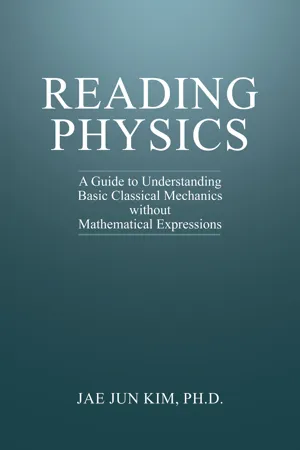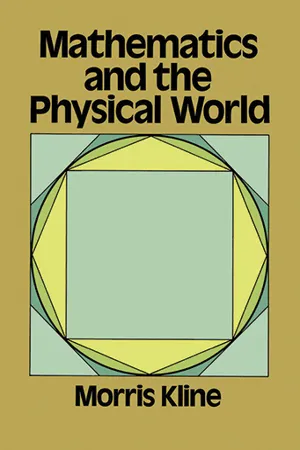Physics
Velocity of a Projectile
The velocity of a projectile refers to the speed and direction at which the projectile is moving. It is a vector quantity, meaning it has both magnitude and direction. The velocity of a projectile can be influenced by factors such as initial speed, angle of launch, and air resistance.
Written by Perlego with AI-assistance
Related key terms
7 Key excerpts on "Velocity of a Projectile"
- eBook - ePub
- Brendan Burkett(Author)
- 2018(Publication Date)
- Human Kinetics(Publisher)
- In many sports, objects (or athletes) are projected or propelled into the air. Their trajectories depend on their velocity, height, and angle of release.
- The forces exerted by gravity and air resistance help determine the resulting flight path.
- With no air resistance, a trajectory angle of 45° produces the greatest distance for objects projected from ground level on a horizontal surface. When the object is projected from above ground level, an angle less than 45° produces the greatest distance.
Summary
- Speed is a scalar measure indicating how fast an object is traveling, measured by dividing the length or distance traveled by the time, but speed does not quantify the direction of travel.
- Velocity is the change in position divided by the time.
- We can measure the velocity of the whole body (for example, the whole body of a runner), or we can measure the velocity of individual components (for example, the velocity of just the runner’s leg).
- Acceleration is the rate of change of velocity; an increase or decrease indicates acceleration or deceleration.
- Current-day technologies can be adopted to automate (or semiautomate) the process of measuring linear velocity.
- When the direction and amount of the applied force are known, the combination of these two items is called a force vector.
- Three key factors influence the linear motion of a projectile: angle of release, speed of release, and height of release.
- The key, but subtle, difference when understanding motion is to determine the perspective; is the motion generated internally by the athlete to project something externally, or is the athlete the projectile?
Key Terms
- acceleration
- angle of attack
- apex
- deceleration
- force
- force vector
- ground reaction force
- linear motion
- linear velocity
- negative acceleration
- eBook - ePub
Sports Biomechanics
The Basics: Optimising Human Performance
- Prof. Anthony J. Blazevich(Author)
- 2017(Publication Date)
- Bloomsbury Sport(Publisher)
FIG. 3.1 Tennis ball trajectory. Gravity accelerates the ball towards the ground at the same rate regardless of whether the tennis player leaves the ball to fall freely or hits it perfectly horizontally. However, the trajectory of the ball is different in these two circumstances.Projection speedThe distance a projectile covers, its range, is chiefly influenced by its projection speed. The faster the projection speed, the further the object will go. If an object is thrown through the air, the distance it travels before hitting the ground (its range) will be a function of horizontal velocity and flight time (that is, velocity × time, as you saw in Chapter 1 ). In Figure 3.1 , you can see that a ball thrown in the air by a tennis player will hit the ground at the same time regardless of whether it is hit horizontally by the player or allowed to fall freely but the trajectory of the ball is different.If the projectile moves only vertically (for example, a ball thrown straight upwards), its projection speed will determine the height it reaches before gravity accelerates it back towards the Earth. If we don’t take air resistance into account, gravity accelerates all objects at the same rate: 9.81 m·s-2 barring some regional variations around the planet* . This is about the same acceleration a lion can achieve or twice the acceleration of the fastest humans. To get an idea of how fast it is, drop a small ball from a height of a few metres and watch it accelerate as it falls.What might position (displacement), velocity and acceleration graphs look like for a ball thrown vertically? Projection angleThe angle of projection is also an important factor affecting projectile range. If an object is projected vertically, it will land back at its starting point, after gravity has pulled it back to Earth (remember, the object is accelerated positively the whole way if ‘down’ is assigned the positive direction). So, its range is zero. If the object is projected horizontally from ground level, it will not get airborne, so again its range is zero. It can also be projected at angles between 0° and 90°, where it will travel both vertically and horizontally. At a projection angle of 45° the object will have an equal magnitude of vertical and horizontal velocity and its range will be maximised, as you can see in Figure 3.2 - eBook - ePub
Doing Physics with Scientific Notebook
A Problem Solving Approach
- Joseph Gallant(Author)
- 2012(Publication Date)
- Wiley(Publisher)
Chapter 4Projectile Motion
The 1-dimensional kinematics of Chapter 2 allow us to describe horizontal or vertical motion in a straight line. Vectors allow us to analyze 2-dimensional objects. Now we combine the two and use vectors to describe 2-dimensional motion. A 2-d kinematics problem is really two 1-d kinematics problems and we use vectors to break the analysis into components.One example of 2-d motion is projectile motion, where an object is launched with an initial velocity and then is influenced only by gravity and air resistance. The object’s initial coordinates are x0 and y0 . Its initial velocity has magnitude v0 and direction θ0 above the horizontal.The horizontal component of the initial velocity is vox = v0 cos θ0 and the vertical component is voy = v0 sin θ0 . This unusual notation is due to a limitation of SNB: the engine can’t handle a double subscript unless the indices are either both numbers or both letters. So we’ll use vox instead of vox and voy instead of v0y. Here is a summary of the notation for the velocity and position of our projectile.Table 4.1With the equations of 1-dimensional kinematics and vectors, we can analyze projectile motion with and without air resistance. We will calculate the horizontal position x and the height y as functions of time directly and separately, and calculate the trajectory, the mathematical description of the path of the projectile that gives the projectile’s height as a function of horizontal position. We will also calculate how far the projectile travels horizontally before landing, how much time it spends in the air, and its maximum height.No Air Resistance
In the absence of air resistance, the only influence on the projectile is gravity. Near the Earth’s surface, the acceleration due to gravity is constant so we can use Eqs. (2.5) and (2.6) - eBook - ePub
- Hiqmet Kamberaj(Author)
- 2021(Publication Date)
- De Gruyter(Publisher)
the x, y and z axes. 4.3 Projectile motion We often have observed a baseball in motion or any other object thrown into the air, such as an arrow shown in Fig. 4.5. By definition, this kind of movement is called projectile motion. Figure 4.5 An example of the projectile motion. v total represents the total velocity at any point of the projectile motion; v x and v y are, respectively, the x and y components. α is the angle formed by the direction of v total and x -direction, which varies from point to point along the trajectory. Assumptions of projectile motion In this motion, the ball follows a curved path, and its motion is simple to analyze if we make two assumptions: 1. The free-fall acceleration g is constant over the range of motion and is directed downward. 2. The effect of air resistance is negligible. Taking into account these assumptions, we will find in the following that the projectile motion’s path of a projectile (or the trajectory) is always a parabola. To show this, we consider the projectile motion in a reference frame such that the y -axis is vertical, and its positive direction is upward. Since the air resistance is neglected, we know that a y = − g (as in one-dimensional free fall) and that a x = 0. Also, the projectile is initially (t = 0) positioned at the origin (x i = y i = 0) with velocity v i, as shown in Fig. 4.6. The vector v i makes an angle θ i with the horizontal, where θ i is the initial angle (at the origin) between the direction of v i vector and the x -direction. Figure 4.6 Projectile motion of the baseball. From the definitions of the cosine and sinus functions, we obtain the x and y components of the initial velocity: (4.29) v x i = v i cos θ i v y i = v i sin θ i. Substituting the x component from eq. (4.29) into eq. (4.25) and taking x i = 0, a x = 0, we - eBook - ePub
Reading Physics
A Guide to Understanding Basic Classical Mechanics without Mathematical Expressions
- Jae J. Kim(Author)
- 2023(Publication Date)
- Universal Publishers(Publisher)
Day 11 Projectile motion You throw an object in the air, and it is going to fall to the ground. How would you describe the motion in terms of all the quantities that we have studied so far?You hold a coin. You keep the distance between the coin and the floor at 1 mile and then release it. Calculate the change of velocity associated with the coin in the vertical direction per second. How large is it, and why is that?If you understand the basics of a projectile motion in classical mechanics, then you can proudly say loudly that you do have some understanding of what motion is about in classical mechanics. It is important to understand projectile motion. It deals with a motion associated with an object or objects in two- or higher dimensional space. The things that we’ll cover may not be all that intuitive, so let us spend some time going over some of the details one by one.Again, it all starts with something in motion, where the change in position is realized over time. Imagine that someone throws a ball in the air with a certain velocity and angle with respect to the horizontal direction. Question: can we find the size of the displacement of the object in the horizontal direction and how high the ball went up in the air from the size of the initial velocity? In other words, can we find how far the ball moves and how high the ball goes in the air? Understanding the relevant procedures to find the answers is the most important part that you need to get familiar with when studying a projectile motion, and that will certainly lead you to a better understanding of kinematics overall. After that, you can go over more complicated questions. Or the complicated questions will come to you naturally as you get more interested in studying physics.At this point, please go over all the figures in this lesson first and come back here. It is going to help you understand the main point better.Let us go over the procedure in more detail. When the velocity and the direction are given, what we can do first is calculate the velocity in both the horizontal and the vertical direction, which we can do with the initial velocity as a vector, something that we covered in the first two lessons. For instance, when the velocity is 100 m per sec and the direction with respect to the ground surface is 30 degrees, we can find the velocity component in the horizontal and vertical direction. Yes, we can. Have a look at Figures 11.1 and 11.2 - eBook - ePub
- Morris Kline(Author)
- 2012(Publication Date)
- Dover Publications(Publisher)
x in the horizontal direction is(6)Since this velocity is constant, the horizontal distance x traveled in time t is(7)The vertical motion is slightly more complicated. If there were no gravitational force pulling the projectile downward, it would continue to travel upward at the constant velocity V sin A . However, as the projectile rises gravity pulls it down. Now we saw in chapter 12 that any object subject to the action of gravity will have an acceleration in the downward direction of 32 feet per second each second and will therefore acquire a downward velocity of 32t feet in t seconds. Hence the first statement we may make about the vertical velocity of the projectile is that its net velocity v y at any time t is(8)How far above the ground will the projectile be any time t? Well, the velocity V sin A will cause the projectile to rise Vt sin A feet in t seconds. During these t seconds the action of gravity will pull the projectile downward 16t 2 feet. Hence the net vertical distance y attained by the projectile in t seconds is(9)In deriving formulas (8) and (9) we have assumed that the motions of rising and falling may be considered separately, even though they take place simultaneously. But each motion is due to a separate and independent force, just as the horizontal and vertical motions are independent, and, consequently, our derivation rests on a sound physical principle.Formulas (7) and (9) describe the separate motions in the horizontal and vertical directions, each giving a distance in terms of time t . For any given time t we could calculate x and y and thus know where the projectile is at that time. However, we might like to know what the actual path of the projectile is without having to calculate successive x and y - Paul Grimshaw, Neil Fowler, Adrian Lees, Adrian Burden(Authors)
- 2007(Publication Date)
- Routledge(Publisher)
Fig. B5.5.ConsideringFig. B5.5in terms of the vertical component of the ball’s motion, we can see that it travels upward and downward (displacement/time graph;Fig. B5.5: graph 1) with a decreasing vertical velocity (positive value) as it travels upward. The ball then reaches the peak height of the flight path and the velocity changes direction (i.e., it stops going upward and instantly starts coming downward) and throughout this action it has been accelerating at a constant rate (–9.81 m/s2 ) with a decreasing positive vertical velocity and an increasing negative vertical velocity (graphs 2 and 3). This is exactly the same as when the ball that was thrown perfectly vertically (providing the vertical release velocity was the same in both experiments). Horizontally, the ball will be displaced as shownFig. B5.5: graph 4. It will travel forwards with constant horizontal velocity (graph 5) in accordance with Newton’s first law and it will do so with zero horizontal acceleration (constant velocity horizontally as in graphs 5 and 6). Hence, vertical and horizontal motions during projectile flight are independent of each other and gravity affects the vertical component only.Fig. B5.5. The graphical representation of the motion of a ball thrown with vertical and horizontal velocityAir resistance
In the understanding of vertical projection it is worth making a comment about the effects of air resistance. Normally, in human motion we consider the effects of air resistance to be negligible (particularly on the human body as it travels as a projectile through the air). However, in certain applications the effects of air resistance will not be negligible and will be considered as an external force that affects motion. For example, in the case of dropping objects vertically, we know from Newton’s law of gravitation that any object near to or on its surface regardless of its mass will accelerate toward the ground at a constant rate (i.e., two objects of different masses when dropped at the same height will both hit the ground at the same time). However, if you take the case of dropping a piece of paper and a golf ball you will see that the golf ball will hit the ground first. In this case air resistance will affect the piece of paper by a significant amount such that its descent towards the Earth will be slowed down (air resistance becomes an external force). Similarly, in sports such as javelin, hammer throwing, and discus, and even to an extent in long jumping when there are “head and tail” winds air resistance will have an effect. Often long jumps that are wind assisted are not legitimate jumps (in this case the tail wind would be an external force of assistance). Hence, in certain sports and movements it may be the case that the air resistance effects should be considered to be more than negligible. Experiment with dropping different objects from the same height to see if you can demonstrate the effects of air resistance on the vertical downward acceleration of objects caused by the force of gravity
Index pages curate the most relevant extracts from our library of academic textbooks. They’ve been created using an in-house natural language model (NLM), each adding context and meaning to key research topics.






